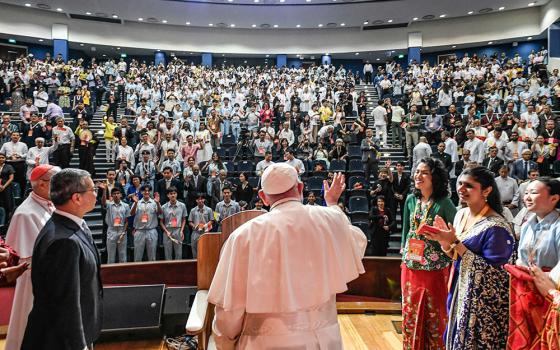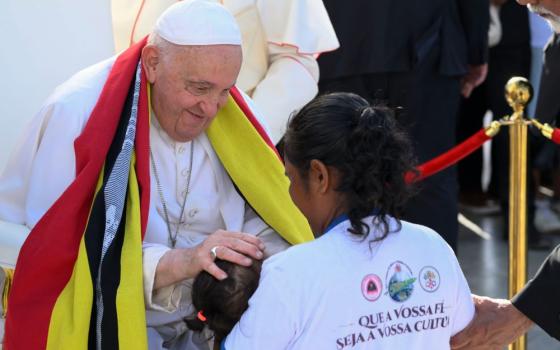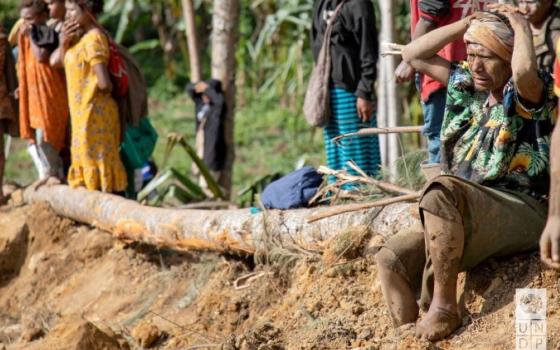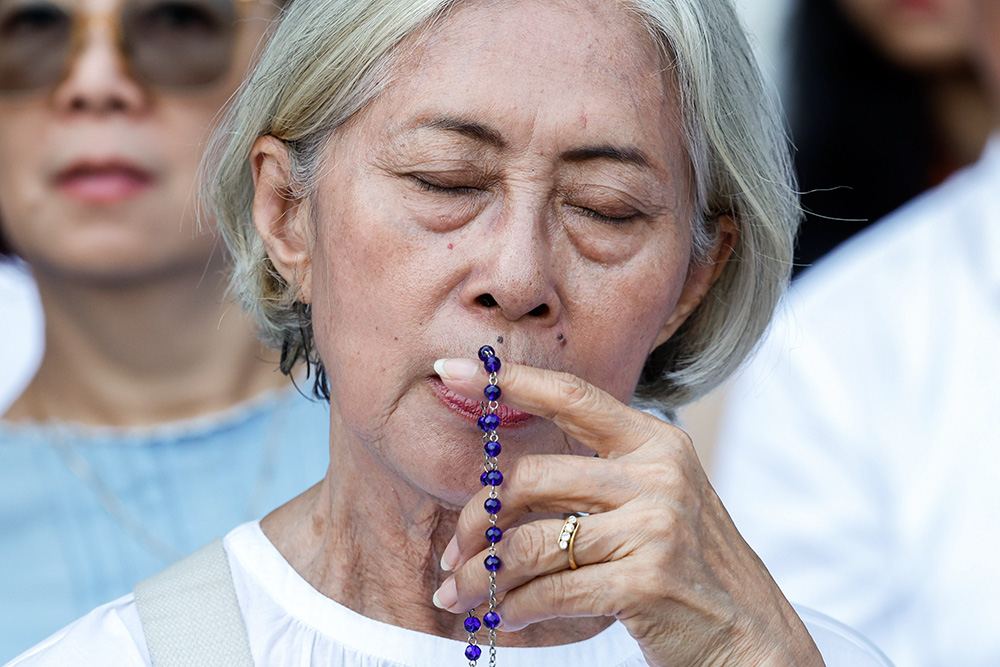
A woman prays as she awaits Mass with Pope Francis at Gelora Bung Karno Stadium in Jakarta, Indonesia, Sept. 5. (CNS/Lola Gomez)
Pope Francis' two-week trip in Asia and Oceania showed how he continues to surprise many while also keeping the door open for constructive criticism.
A move forward
First, the papal trip signified a move forward. Despite all the news about the pope's health, this trip has shown to the world, and most importantly to the church, that Francis is alive and sharp. He is able to push forward and to lead "into the wild."
Throughout this trip of about 20,000 miles, the pope demonstrated his physical and mental capacities to engage with extremely diverse people and local situations. In each context, he carefully adjusted his tone and message in order to respect the intricate dynamics of each country. Diplomatic and bold, Francis invited peoples of Southeast Asia — and their powerful partners — to search for the common good and move forward.
As this long march across Asia was physically challenging, several important cardinals of the Vatican were unable to join. Also, because of the death of his mother, Cardinal Pietro Parolin had to cancel his participation.
With a reduced guard, Francis remained energetic and joyful. He reminded us that we may not be yet at the end of his papacy and demonstrated that his leadership remains strong, which will have consequences for the synodal assembly next month in Rome.
The evolving nature of Catholicism
The trip also revealed the evolving nature of Catholicism. Throughout this extended journey, many people discovered that the most Catholic nation in the world is in Southeast Asia: Timor-Leste. This nation entirely converted to Catholicism only 40 years ago!

Young people wait for Pope Francis outside a convention center in Dili, Timor-Leste, Sept. 11. (CNS/Lola Gomez)
This goes against numerous discourses about the church in Asia — something supposedly marginal, poor, and left from the colonial past. This papal trip was a reminder that it is urgent to question our modernist biases about Catholicism.
In this part of the world like elsewhere, the church is alive, complex and changing. Some situations can even challenge our comforting beliefs about Catholicism. As I have explained in my public responses to Cardinal Luis Antonio Tagle and Colm Flynn, Pope Francis is inviting Catholics to go beyond their national creed and pay more attention to the rest of the church.
In our search for the body of Christ, orientalist discourses are misleading. Participating actively in processes of globalization that connect people across oceans, Francis is inviting us to question our economic, political and ecclesial ways to marginalize and sometimes dismiss entire populations.
The gift of collaboration
The pope's visit similarly demonstrated the gift of collaboration. This visit was not only about a lively pope and a changing church. It was also about the Southeast Asian region and its capacity to come together. To make this trip happen, organizers had to rally numerous people and institutions in each visited country, and also in the Vatican and Italy, and beyond. For instance, American, Australian and Singaporean intelligence services, as well as the Australian air force were mobilized to make this papal visit possible and safe for all.
Yet, in terms of security, the most challenging part was not in Indonesia! Muslims deeply appreciate Francis' moral leadership. Rather, the challenge was in Papua New Guinea where Christian extremism and communal gun violence are major problems. On this tormented island, Francis traveled to a remote village to emphasize the need to overcome greed, division and violence, and to honor the beauty of the country and its peoples.
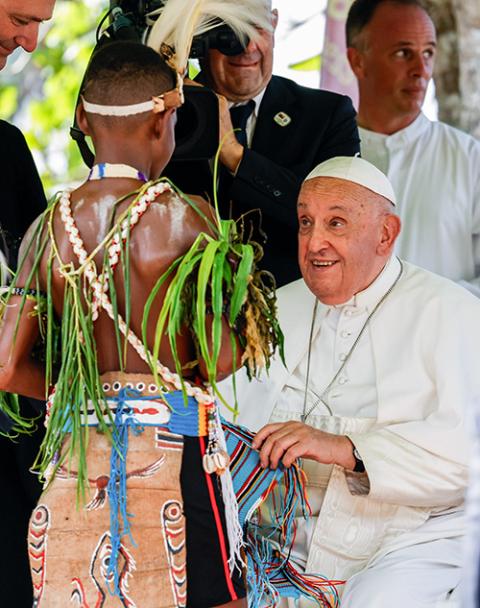
Pope Francis receives a gift from a child in traditional dress at the Holy Trinity Humanistic School in Baro, Papua New Guinea, Sept. 8. (CNS/Vatican Media)
Through the many collaborations that this Asia-Pacific trip has made possible, this apostolic journey became a statement against selfish antagonism and violent competition. Francis generated very large interest, particularly in Indonesia, Papua New Guinea and Timor-Leste.
His presence opened spaces for cross-communal deliberations on collective challenges such as social justice, regional integration and interreligious engagement. Humble but bold, Francis did not come with premade answers but fraternal questions.
At a more political level, by interconnecting the poorest and richest corners of Asia, this trip illustrated the type of all-encompassing care and universal sovereignty that the pope embodies. His fraternal visit has once again demonstrated the Vatican's capacity to engage with complex social, political and religious issues of Asian societies. The message for political leaders of Southeast Asia, China and India is that a papal trip offers a chance to mobilize rather than being a risk to manage. Building regional collaboration is the way forward.
The need for interreligious engagement
Another trip takeaway was the need for ongoing interreligious engagement. Among the various forms of collaborations encouraged by the pope, special attention to interreligious dialogue came on the first and last days of the trip. In Indonesia and Singapore, which both have very different models of interreligious coexistence, national development and democracy, the pope emphasized the need to go beyond our comfort zones.
In Jakarta, through his car, humble gestures and his cheap watch, the pope caught the heart of millions of Indonesian Muslims. In this country, with the largest Muslim population in the world, Francis generated a huge enthusiasm among the general public, which did not seem to receive enough international attention. For many Indonesians, Francis exemplifies what a selfless and virtuous leader should be.
Advertisement
Domestically, the papal visit gave support to Indonesians advocating for moderate Islam. Internationally, it projected Indonesia as a model of interreligious coexistence to illustrate that Christians and Muslims are not necessarily condemned to fratricidal wars.
In the sanitized Singapore, the pope met with youths from different faiths a few hours before his final departure. For this extremely rich microstate that the Pew Research Center recently ranked as the most religiously diverse country in the world, interreligious harmony is vital.
Here, Francis went off his prepared remarks to engage in direct dialogue with young Singaporeans. Emphasizing the need to be critical and to accept critics, the pope made them repeat "Take Risks! Take Risks!" — a new motto for interreligious engagement.
The cancer of sex abuse
The trip's final takeaway deals with the cancer of sex abuse. The pope mentioned the issue of sex abuse in Timor-Leste. In a country marked by many forms of injustice and where several clergy members face allegations of sex abuse, it was important to find the right way to name this tragedy without making other challenges of the country disappear. It would be unfair to put all the emphasis on sex abuse only. Justice requires balance.
Yet, when one sees Francis going to Canada, Portugal and Belgium to meet with sex abuse victims, one can only wonder why nothing similar was scheduled during these 12 days in Asia.
As the abuse allegations against Bishop Carlos Filipe Ximenes Belo of Dili, Timor-Leste, and the French Missions Etrangères de Paris priests across Asia illustrate too dramatically, Asian churches are also suffering from this clerical cancer. The Vatican should not build a hierarchy of engagement and justice with sex abuse victims. Asian victims are not less important than Western ones.




